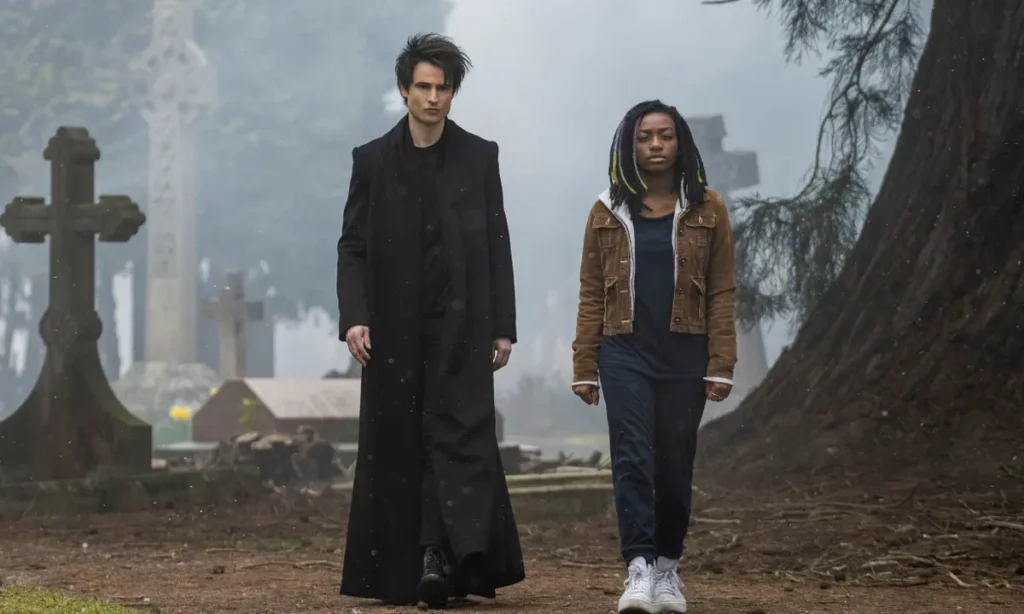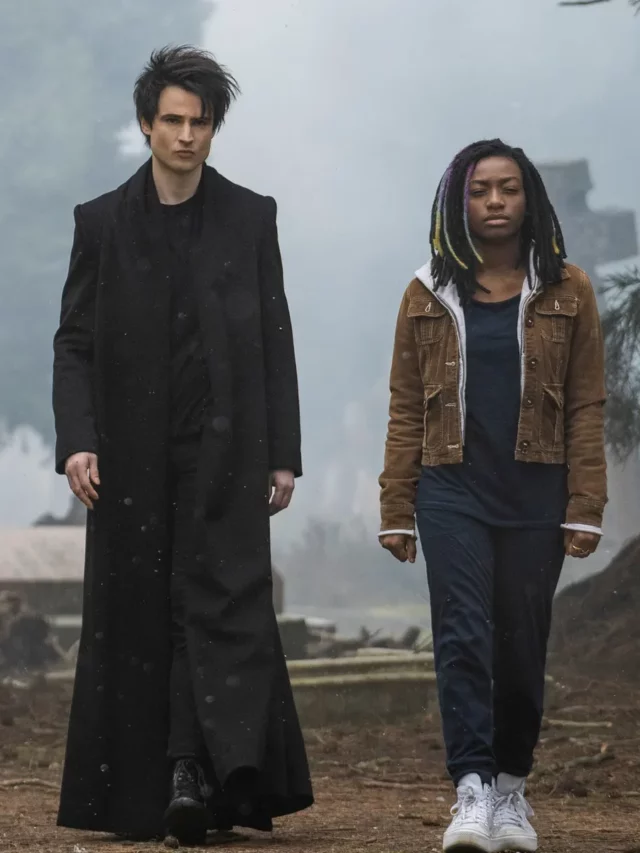‘the Sandman’ On Netflix Is A Dream Come True For Fans And Non-fans Alike
I know it took forever, and there have been a good number of aborted attempts along the way, but the Netflix adaptation of the landmark comic series just … seems to work.
The comic succeeds in presenting a faithful representation of the look, feel, and the story of the Lord of Dreams as presented in the comics, which were written by Neil Gaiman with art by Sam Kieth, Mike Dringenberg, and a large number of other pencilers and inkers over the course of its existence.
As an adaptation, however, this work succeeds far more so than as a work of fiction.
In contrast to the audiobook versions of the 1989-1995 comic series that strictly adhered to every tiny detail (and in doing so, ended up feeling both dated and overwritten), the Netflix series’ grip on the source text is gratifyingly looser than the audiobook versions. As a result, it breathes.
‘the Sandman’ On Netflix Is A Dream Come True For Fans And Non-fans Alike
Characters and storylines have undergone significant changes, big and small, in order to streamline, update and focus the narrative so as to meet the specific propulsive demands of serialized television.
To everyone else who comes to these stories and characters for the first time: Okay, I have absolutely no idea how you’re going to react to this.
There is a lot going on in the show, just like in the comic, from the moment you start reading it.
However, I believe there is a better than average chance that you will finally start to understand why the rest of us have been pestering you to read this comic for all these years and why we have been pleading with you to do so.
Like sands through the hourglass…
The Sandman is the story of Morpheus, aka Dream, who is the hero of the story. He is one of The Endless, a collection of abstract concepts (Dream, Death, Desire, Despair, etc.)
that take on the anthropomorphic shape of bickering siblings as if they were bickering siblings themselves. In spite of the fact that they are immensely powerful and immortal, even so, they are bound by a number of rules and duties as they oversee various aspects of human life.
For his part, Morpheus controls The Dreaming, which is a vast realm of adventures, delights, and horrors that humans visit when they sleep.
The story begins in 1916 when a self-proclaimed British occultist traps Morpheus within a magic circle and robs him of his tools of office in the process.
There is no doubt that the magus was aiming to capture Morpheus’ brother Death, but he must have transposed a rune or two, the poor sap.
In the first story arc of what became a 75-issue series, Dream escapes after many years of captivity and sets about repairing the damage he has caused to his realm as well as the waking world as a result of his absence.
He attempts to gather up the dreams and nightmares that have escaped the Dreaming in the second arc of the story.
As you can see, both of these first storylines are covered in the 10 episodes of the Netflix series.
From horrific to mythical
There is no doubt that the comic is beloved, and it has been recognized for its merits by a number of awards and acclaim.
While it is important to keep in mind that everything the comic has become over the course of its 75 issues – a sweeping, sprawling epic of myths and monsters that takes as its subject nothing less than the power of stories to change the world – was not what it was at its inception.
There was an intention for The Sandman to be viewed as a horror comic, and the marketing materials featured an image of Morpheus cradling a pile of sand in his palm alongside a line from T.S. Eliot’s The Waste Land: “I will show you the fear of a handful of sand in my hand.”
Moreover, it was created by a young writer who was still discovering his voice, still stepping out of the shadow of writers such as Alan Moore and Stephen King.
For example, you could take a look at its sixth issue, which is set in a diner where a character uses one of Morpheus’ tools to cruelly torment the staff and customers.
The storyline involving child abuse, sexual violence, and serial murder was widely praised at the time, as well as the storyline that followed.
Having read these issues more than once, I can say that they remain harrowing even though they are done in a manner that is facile and unearned.
As a result of their lurid shocks, it seems as though the author was trying to see what he could get away with, preferring glib cleverness over the truth from an emotional standpoint.
In a sense, there is an essential emptiness that flattens the characters into so many writing exercises meant to elicit our reflexive disgust rather than our understanding of the characters from an empathic perspective.
It is true that there are horror-story elements still present in the Netflix series, but in adapting them for the screen, producers Gaiman, David S.
Goyer and Allan Heinberg have made choices that go deeper and resonate more deeply with the audience.
The comic, like so many narratives before and since, relied on violence against children, women, and marginalized communities to spur its white-knight protagonist into action; however, the Netflix series is eager to give such characters more agency, more independence, and a richer life experience by making them more complex and rounded.
Every choice we make in the process of adapting the story leads to a more sincere, more humane, and more emotionally expansive interpretation of the story.
As a result, writing that was originally wrapped up in self-satisfied cleverness now feels deeply thoughtful and engaged from the outset.
As a result, the series is effectively setting itself up for a long run in the future.
There is no doubt that if The Sandman receives the number of subsequent seasons it deserves, it will become a deeply emotional and intimate show, about a man whose sense of duty and inflexible, preconceived sense of self keeps him from engaging with others, and from experiencing the kind of emotional growth that is necessary for him to adapt to a changing world.
As the comic developed, its writing grew beyond its familiar, reductive horror trappings to embrace and meaningfully engage such deeper truths in its narrative and writing. This work is already being done by the Netflix series.
Its hero carries the series on his bony shoulders
Moreover, all of that good, chewy, satisfying work is aided immeasurably by the casting of Tom Sturridge as Morpheus, which adds immeasurably to the enjoyment of the film. There is no doubt that he looks the part, with his alabaster skin, sculpted cheekbones, lean frame, and Robert Smith hair.
There is a throaty whisper that he uses for most of his lines that reminds me both of an ASMR Youtuber and Eddie Redmayne in Jupiter Ascending (except for the non-shouty bits).
Is there any other way you could imagine giving a voice to the Morpheus of comic books, whose striking word balloons (ingeniously designed by the great Todd Klein) were rendered as solid black with white lettering?
The most important thing about Sturridge’s performance is that he captures all the competing aspects of Morpheus that are forever roiling beneath his impassive surface – the haughtiness, the wounded vulnerability, the stiffness, the longing for connection that lurk beneath it all.
There is also his brittle anger, his ability to laugh at himself almost, not quite, but almost, and his ability to feel numb.
It is interesting to see how the series smartly beefs up the role of Dream’s librarian, played here by Vivienne Acheampong; we learn that unlike in the comic, the reason she keeps her loyalty is not borne solely from blind duty, but rather from her own deeply personal sense of duty.
As Boyd Holbrook depicts the rogue, eyeball-chomping nightmare The Corinthian — whose role has also been greatly expanded from the comic to good effect — it oozes a malignant charm that is eerily reminiscent of the comic.
In their roles as Dream’s immortal siblings, Kirby Howell-Baptiste and Mason Alexander Park evoke the iconic elements of their characters, while making the roles their own in such a unique way.
Moreover, David Thewliss, who plays a would-be supervillain, is able to shift fluidly between pitiable wretch and malicious manipulator; his motivation is also a crucial element in clarifying his character’s goals, which are somewhat murky in the comic.
A distillation of the comic
In watching these 10 episodes unfold, readers familiar with the comic will notice how much more cleanly and clearly the story is unfolding now that it has been freed from the editorial mandates that Gaiman and his collaborators had to navigate in the past.
Without, for instance, having to squeeze in a cameo from the Justice League, pay homage to Hell’s ruling hierarchy being shaken up by another comic book writer, or unravel pre-existing DC characters’ backstories that had been mangled by multiple relaunches and reboots, the Netflix series simply unfolds Dream’s travails, confidently collapsing characters and storylines.
Adaptations of comics provide interesting new variations on themes that fans of the comic are already familiar with, without erasing what they love.
They make those moments when characters from the comics appear on the screen even more satisfying. As I reread the comic, I am delighted when the Fates appear in corporeal form; they are some of Gaiman’s most intriguingly creepy, inscrutable, and darkly funny characters – and their Netflix versions don’t disappoint either.
As it went, issue after issue, until the comic reached its profoundly satisfying conclusion, the comic only became richer, bolder, and more immersive as it went, issue after issue.
There is no doubt that Netflix’s series deserves the chance to do the same. Let’s hope that it gets there in the end.



